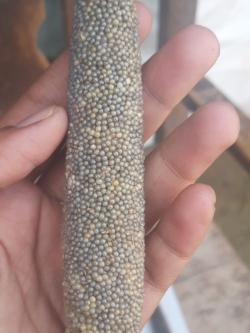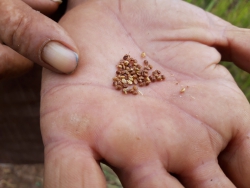|
Biological Diversification
Bundelkhand,
an extremely climate sensitive region situated in Madhya Pradesh and
Uttar Pradesh in Central India has faced many consecutive droughts over
the past few decades. Other than erratic rainfall patterns, some of the
reasons for this are changes in cropping patterns, decreasing forest
cover and poor soil and water conservation measures.
Climate change and the need to address biodiversity conservation have gained enough traction in the past two decades. Whether itís the COVID-19 pandemic or cyclone Amphan which created havoc in the eastern parts of the country or the recent oil spill in Tinsukia in Assam, issues concerning biodiversity need more attention than ever. Imagining a post COVID-19 world without addressing biodiversity concerns will only aggravate the situation. A sustainable, equitable and resilient food system (SDG Goal 2- Zero hunger) is among the most important responses to build the new normal. This article throws light on how to create biological diversification in agriculture to achieve food and water security. Land and Water Management Conservation of local biodiversity and sustainable management of natural resources form a positive feedback loop with each enhancing the other and leading to positive outcomes for overall ecological sustainability. Sustainable management of land and water not only allows the conservation of these natural resources resulting in improved water security and soil health but also yields considerable co-benefits in terms of biodiversity regeneration. Improved availability of water in the ground promotes rapid biomass generation and improved green cover which in turn creates suitable conditions for enhanced local biodiversity. Improved local biodiversity in turn sustains the food production systems in multiple ways. Pollination agents such as bees, whose population has seen a rapid decline over the years, make a comeback. Other local fauna act as natural systems of pest control. The diversity in soil micro-organisms enables more efficient nutrient recycling. Improved green cover of trees help in preventing soil erosion losses and recharge of groundwater.
Promote Biodiverse Production Systems Biodiverse production systems such as agro-forestry and agri-horticulture help farmers reduce their vulnerability to climate change impacts. These models promote practices such as green-manuring and inter-cropping with legumes that help depleted soils to regain health and productive potential. More offbeat systems of bio-diverse production systems include the cultivation of fishes and shrimps in paddy fields. These forms of agricultural diversity are not only less vulnerable to climate impacts but also represent new revenue streams for the farmer. Each species in an agro-ecosystem is part of a complex web of ecological relationships connected by flows of materials and energy. This explains why decline in diversity of agricultural systems leads to breaks in many of these ecological flows and thereby an overall reduction in productive potential. Encourage Growth of Millets Indiaís agricultural policies targeted at achieving food security outcomes have narrowly focused on increasing the production of wheat and rice leading to a decline in the cultivation of grains such as millets and consequently their representation in our diets. This has led to loss of crop diversity and negative consequences on the nutrition security of people. Millets are eminently suitable for rain-fed areas such as Bundelkhand as they are adapted to conditions of low water availability. The needless shift of cultivation from millets in this drought prone region has brought with it livelihood loss as farmers have suffered crop losses due to wheat and rice crops failing under conditions of poor rainfall. Moreover, promotion of resource intensive crops in such a resource starved region has led to over-extraction of natural resources and water and soil contamination because of excessive use of chemical fertilizers. This is only one of the many examples that demonstrate how the loss of agricultural biodiversity leads to livelihood insecurity. A first step towards correcting this and improving food security in the Bundelkhand region must be to help farmers diversify and grow multiple crops in the upcoming crop season which are suitable for the area. Growing less water intensive crops like millets, vegetables, legumes, oilseeds will be less cost intensive for the farmers and promote water security as well as food security in the region. Millets were an important part of the traditional food basket of the Bundelkhand area but have now vanished from the region. Kodo, Kutki (Little Millet), Bajra (Pearl Millet), Jowar (Sorghum) and Cheena (Proso Millet) were grown historically and seen as energy providing foods. Common ways of consumption included in the form of roti or gruel. Nutritional benefits from millets as stated by some of the older farmers is that diseases were not frequent when millets were consumed in the region. Millets can withstand tough conditions like poor soil, variable rainfall and undulating rains. Reviving the cultivation of millets is a crucial step in improving the health, biological as well as economic indicators of this drought prone region. Currently the biggest impediment in reviving millet cultivation in the Bundelkhand region is creating awareness among farmers, providing incentives to them for cultivating millets, getting better procurement prices, providing facilities for processing, value addition and better market linkages (SDG Goal 8 - Decent Work and Economic Growth). Instead of promoting millets just as a profitable marketing option, equal emphasis must be given on highlighting its nutritional aspects in a region where more than a fifth of children under the age of 5 years have stunted growth. The main reasons for decline of millets in Bundelkhand was due to less market value, low production yield compared to wheat and rice which are mostly grown using High Yielding Varieties. Apart from this, any development in the area of millets including research or new varietal introduction are not known to farmers. Going forward, Krishi Vigyan Kendras (KVKís) and government line departments must promote the growth of millets and other climate hardy crops. Millets production must be linked with farm based social enterprises covering all aspects of backward and forward linkages including inputs, technical services for processing and marketing. This will help shift the focus away from paddy and may help in the revival of other traditional crops as well. Introduction of millets in the Public Distribution System and with local Anganwadis will ensure better income for the farmers. Agricultural policies must value and actively promote agricultural biodiversity through appropriate mechanisms that incentivise farmers to shift back to a more diverse cultivation portfolio and also in parallel strengthen the market for these crops through promotional strategies such as the inclusion of millets in government programmes such as the mid-day meal scheme. Such measures will lead to the regeneration of localised food systems that also reinvigorate the local rural economy. ■
Sanyukta Kumari
|

